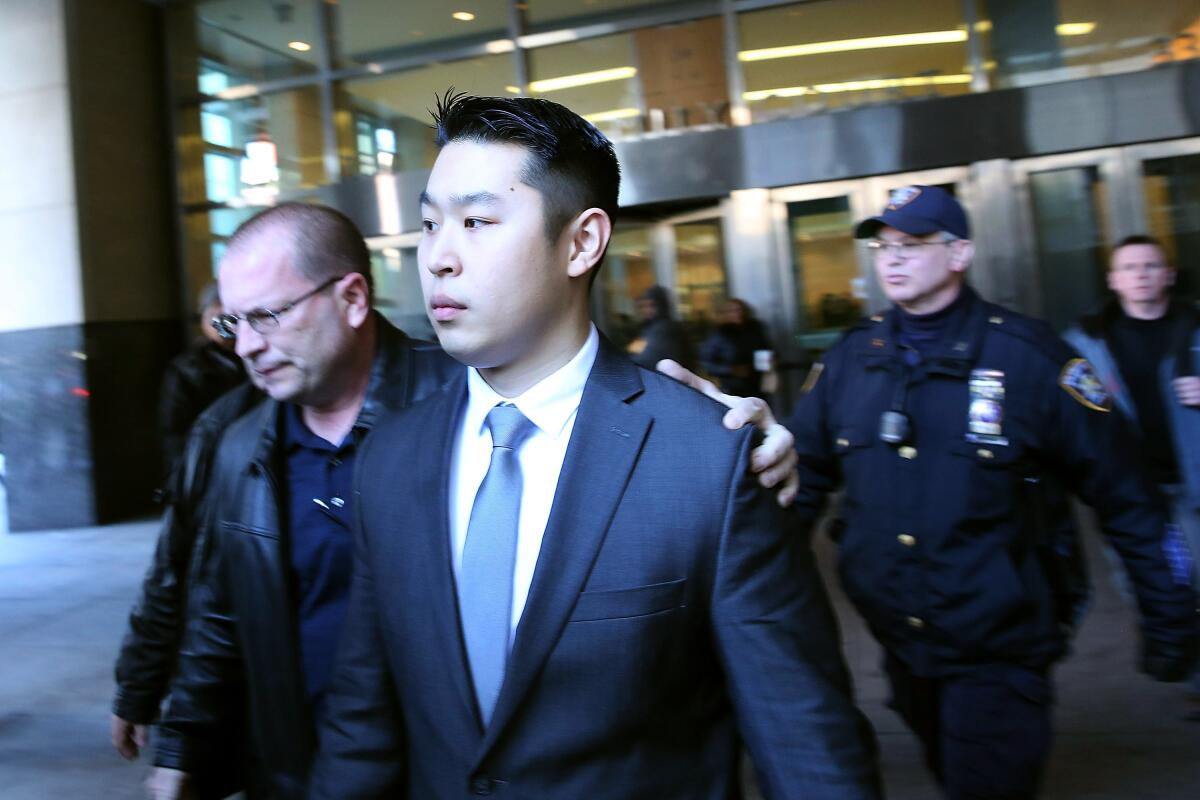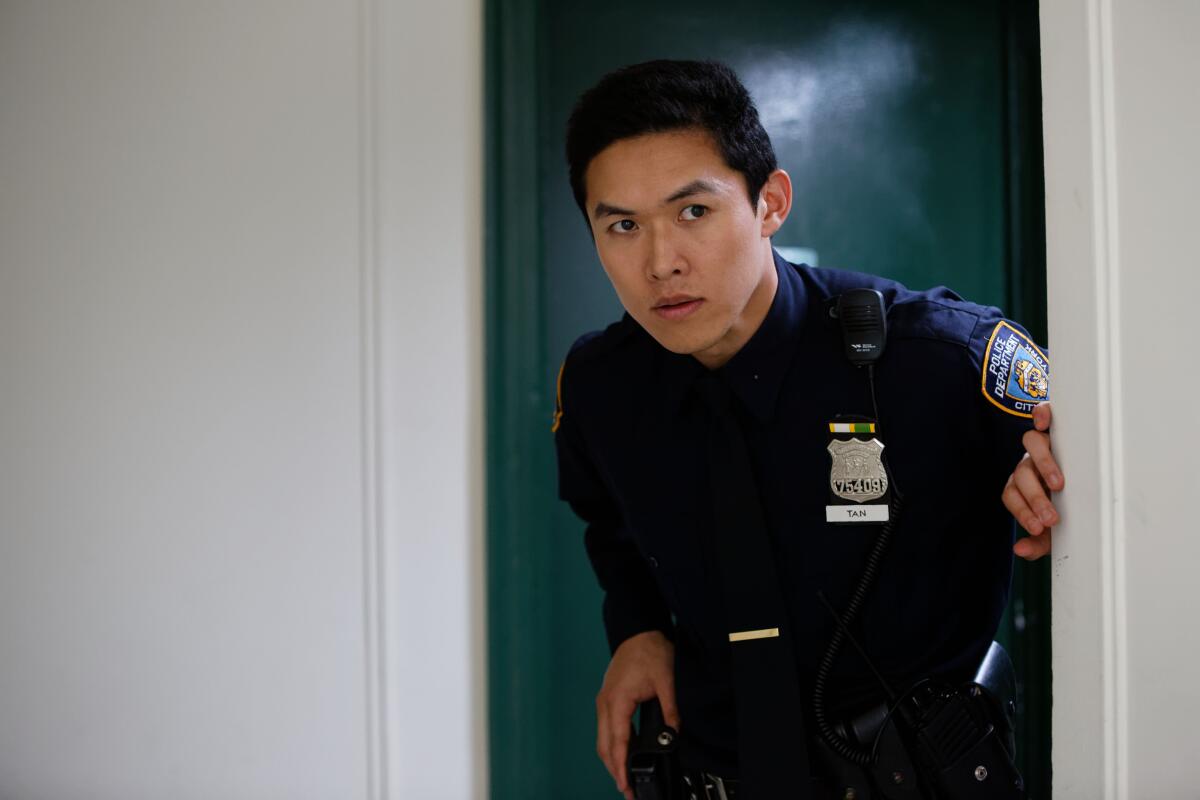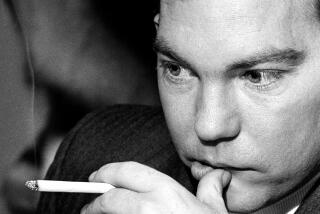A film and documentary try to make sense of the Akai Gurley shooting

It’s been nearly six years since thousands of Chinese immigrants marched across the Brooklyn Bridge in the largest Asian American protest I’ve ever seen in the United States, sparked by the conviction of former NYPD Officer Peter Liang for the shooting death of Akai Gurley.
I traveled to New York City to cover the aftermath for the Los Angeles Times, and it still stands as one of the most challenging reporting experiences I’ve ever had. Both the Black and Chinese communities were angry at the New York City Police Department for different, but valid, reasons. But both groups ended up directing that justified anger at each other, showing up at each other’s protests and staging shouting matches.
Liang, a rookie officer at the time, and his partner were patrolling a darkened stairwell at a public housing project known as the Pink Houses when Liang heard a noise and fired his gun. The bullet ricocheted off a wall and killed a 29-year-old Black man named Akai Gurley.
In the end Liang was indicted and convicted, but did not serve jail time, an outcome which left neither group particularly satisfied. I knew that incidents like these could leave an indelible imprint on community relations, much as the murder of Latasha Harlins polarized Black and Korean communities in L.A. But it was too early at the time to tell what the lasting impact would be.
Years later, two new films have taken on that task. One, a feature documentary by filmmaker Ursula Liang called “Down a Dark Stairwell,” offers an intimate and uniquely multilingual portrait of Black, Asian American and Chinese immigrant protest actions after the shooting.
The other is a feature film called “A Shot Through The Wall,” by Aimee Long, who was inspired by the incident but changed key details of the story.

I met Ursula, who is unrelated to Peter Liang, as she was capturing footage at one of the many panel discussions held in the wake of the Gurley shooting. The late Chinese American photographer, Corky Lee, gave us a ride to Chinatown, where we were both inundated with strong opinions.
“The thing about this incident is that it was so loud and so polarized. It’s a natural thing when things are loud for people to not listen,” Ursula said. “Part of the work of the documentary was to dial down the volume so that people could hear themselves.”
In private, when pressed, Black activists could admit that if Peter Liang had been white, he would have probably never been indicted. Most Chinese Americans I spoke to agreed that no man who kills another man, even if the shot was accidental and the bullet ricocheted, is totally innocent.
But in press releases, on camera interviews and on social media, there seemed to be only these two perspectives: Either Liang was a racist cop who shot Akai Gurley on purpose, or he was an innocent rookie cop scapegoated for the sins of the NYPD because he was Chinese.
Ursula and her assistants track three different groups of activists as they mobilize the Black, Chinese immigrant and Asian American communities, patiently unearthing parallels, commonalities and nuance.
Liang and her collaborators also capture the moments of ugly, racist confrontation that I remember. But the documentary’s quieter moments shine the most. In one scene, a group of Black Lives Matter activists passionately debate whether it is acceptable for a protest chant to use the term “model minority” in a pejorative way.
In another scene that takes place outside the courthouse moments after a judge decided Liang would serve no jail time, a group of cheering Chinese American protesters are confronted by a Chinese man who castigates them in Mandarin, telling them that there is nothing to cheer about when a man is dead.
What frustrated me about the Peter Liang case is that it seemed to be a zero-sum game. It seemed that justice for one community could only be obtained by denying it to the other. But Ursula zooms out from the case’s result and focuses on the movements that sprang up around it.
“Every once in a while something happens that captures people’s attention. It’s not always for the right reasons,” she said, but it fuels change anyway.
Specifically, the Peter Liang case sparked the formation of multiple immigrant-centric civil rights organizations. These groups have lent their muscle to other causes important to Chinese immigrants, such as academic testing requirements at specialized high schools and confronting pandemic-related violence toward Asian Americans. They may take a different side on issues than progressive Asian American groups do, but the fact that they are now increasingly engaged in NYC politics is a net positive, Ursula said.
“The networking that had begun with these local and smaller groups … you just need to insert a new issue and there’s a lot of folks ready to go,” Ursula said.
While the documentary zooms out, the feature film “A Shot Through the Wall” zooms in and imagines the case’s impact on a Chinese American family.
The filmmaker, Aimee Long, was inspired to write the film after visiting home for the holidays one year and finding her entire family arguing about the Liang case.
Long didn’t know where she stood at the time, so she began to think about race more directly than she ever had. She learned about police brutality’s disproportionate impact on Black people, and thought about what being Asian American meant to her, and what it meant in the United States.
What emerges is an aspirational reimagining of the incident that removes the frustrating ambiguity of the Peter Liang case to tell a more personal story.
In her film, key details are fictionalized. Officer Mike Tan has a mixed-race, Black fiancee. Instead of firing a gun into a dark stairwell on patrol as Liang did, the film has Tan and his partner chasing a suspected drug dealer down a lighted hallway when the accidental shot occurs. Instead of ricocheting off a wall, Tan’s bullet tears through a wall and kills a man named Jordan Wiggins.
Long said she wanted to distinguish her film from the Liang case. She focuses on the Asian officer’s family because she wanted to portray genuine Asian American family dynamics, and on those points the film succeeds. I couldn’t help but laugh at how immediately Tan’s mother began to yell at him for his choice in careers after he finally tells her about the shooting. And the scenes around food and long silences at family dinners felt real.
The film includes a protest scene and acknowledges the way the shooting divides the community, but its main focus is on Tan and how he learns to let go of his belief in his own innocence and good intentions. By the end of the film, he accepts that his desire to be exonerated is misguided and apologizes to the mother of the man he shot. Then, in a chance encounter, Tan himself is shot by two other police officers.
“Even though he believed in his own good intentions, he still caused harm,” Long said. “That’s a discomfort that I wanted to include in the film.”
The last scene of the film shows both mothers — in a chance meeting across a produce display. They lock eyes, and there is a moment of recognition and acknowledgement.
Both of them look like they want to say something to each other, but ultimately they remain silent.
More to Read
Sign up for Essential California
The most important California stories and recommendations in your inbox every morning.
You may occasionally receive promotional content from the Los Angeles Times.











